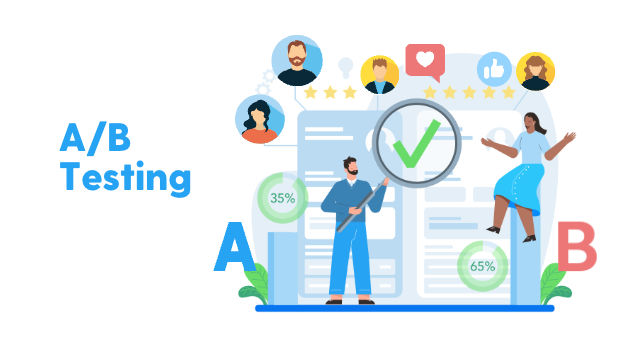A/B testing, also known as split testing, is a vital optimization technique used by businesses to make data-driven decisions. It involves comparing two or more variations of web pages, emails, ads, or any other marketing element to determine which version performs better.
This guide will discuss the A/B testing process, factors to consider, tools and platforms, use cases and examples, best practices, and common pitfalls. We will also highlight the importance of a robust data platform in the process.
A/B Testing Process
A seven-step process for your A/B tests:
- Identifying goals and objectives: Define the specific metrics you want to improve, such as conversion rates, click-through rates, or average order value.
- Formulating hypotheses: Develop informed assumptions about changes that could positively impact your desired metrics.
- Creating variations: Design multiple versions of the web page, email, or ad with the hypothesized changes.
- Setting up the experiment: Use an A/B testing tool to randomly assign users to different variations, ensuring unbiased results.
- Running the test: Monitor the test until you have collected sufficient data to make a statistically valid conclusion.
- Analyzing and interpreting results: Compare the performance of the variations and determine the winner.
- Implementing changes: Apply the winning variation to your marketing efforts and measure its long-term impact.
Factors to Consider in A/B Testing
A. Sample size: Ensure a large enough audience to achieve statistically significant results.
B. Duration of the test: Run the test for an adequate period to account for variations in user behavior and external factors.
C. Statistical significance: Determine the level of confidence in the results (usually 95% or higher).
D. Test validity: Ensure the test design and execution are sound to avoid misleading results.
A/B Testing Use-cases & Tools
A/B testing is applicable wherever there is more than one option. Depending on your business requirement, what metric you are tracking, and the tools + expertise at your disposal, you can identify potential application areas. Here are some A/B testing use cases and examples for eCommerce business:
| Use-case / Example | Factors / Metrics | Tool / Platform |
| Homepage layout optimization | Bounce rate, time on page, conversion | Google Optimize, VWO |
| Call-to-action button colors and placement | Click-through rate, conversion rate | Optimizely, AB Tasty |
| Email subject lines | Open rate, click-through rate | Mailchimp, SendGrid |
| Product page design | Add-to-cart rate, conversion rate | Google Optimize, VWO |
| Pricing strategy testing | Conversion rate, revenue | Optimizely, AB Tasty |
| Landing page headlines | Bounce rate, conversion rate | Google Optimize, VWO |
| Website navigation | Time on page, pages per session | Google Optimize, VWO |
| Personalization and targeting | Conversion rate, revenue, retention | Adobe Target, Dynamic Yield |
| Mobile app user interface | Session duration, in-app conversions | Firebase A/B Testing |
| Checkout process optimization | Cart abandonment rate, conversion rate | Google Optimize, VWO |
| Social media ad creatives | Click-through rate, conversion rate | Facebook Ads, Google Ads |
| Chatbot scripts and responses | Engagement, customer satisfaction | Drift, Intercom |
| Customer support response templates | Resolution time, customer satisfaction | Zendesk, Freshdesk |
| Promotional offers and discounts | Conversion rate, revenue, AOV | Google Optimize, VWO |
Google Optimize, a popular A/B testing and personalization tool, will sunset on July 31, 2023. Going forward, businesses will need to adapt to the changes and explore alternative solutions for their optimization needs. Although Google hasn’t provided a direct replacement for Google Optimize, they encourage users to take advantage of the comprehensive web analytics and reporting capabilities offered by GA4.
As the deadline for the sunset approaches, businesses should start researching and identifying suitable alternatives for A/B testing, website optimization, and personalization to ensure a smooth transition. This may involve evaluating other third-party tools, platforms, or in-house solutions that cater to their specific requirements and seamlessly integrate with their existing tech stack.
A/B Testing Best Practices
A. Test one variable at a time: Isolate individual elements to understand their impact accurately.
B. Prioritize high-impact tests: Focus on tests with the potential for significant performance improvements.
C. Conduct tests regularly: Continuously optimize marketing efforts based on data-driven insights.
D. Integrate A/B testing with other analytics tools: Combine A/B testing data with insights from web analytics, customer relationship management (CRM), and other data sources for a holistic understanding.
Common A/B Testing Pitfalls and How to Avoid Them
Here are some common A/B testing pitfalls along with best practices illustrated with examples:
| Pitfall | Best Practice | Example |
| Insufficient sample size | Running an A/B test with too few participants can lead to inaccurate results and incorrect conclusions. Ensure you have a large enough sample size to detect meaningful differences between variations. | An omnichannel retailer tests a new product recommendation algorithm on their website for only 200 visitors, leading to inconclusive results. A test with 10,000 visitors would have provided more reliable insights. |
| Overlooking statistical significance | Failing to wait for statistical significance can lead to acting on false positives. Make sure your test reaches a significance level of at least 95% before drawing conclusions. | An eCommerce store observes a 10% increase in conversion rate after two days of testing but stops the test prematurely, without reaching statistical significance. Further testing would have shown the increase was due to chance. |
| Testing too many variables at once | Running tests with multiple changes can make it difficult to identify the cause of any observed differences. It’s important to isolate individual variables for more accurate results. | An online clothing retailer tests a new homepage design with multiple changes (color scheme, layout, and font). The test shows a 15% increase in conversion rate, but it’s unclear which specific change led to the improvement. |
| Ignoring external factors | External factors such as seasonal trends, promotions, or technical issues can influence test results. Be aware of these factors when running tests and consider their impact on the data. | An electronics store runs an A/B test on their checkout process during Black Friday, leading to skewed results due to the unusually high volume of traffic and promotional discounts. |
| Focusing solely on short-term metrics | While short-term metrics like click-through rate or conversion rate are important, it’s also crucial to consider long-term metrics such as customer lifetime value, customer retention, and overall revenue. | An eCommerce store tests a new upsell feature that shows an immediate increase in average order value but ignores the potential impact on customer satisfaction and return rates in the long run. |
| Not testing continuously or iteratively | A/B testing is an ongoing process, and businesses should continuously test, analyze, and iterate to ensure sustained optimization and growth. | A furniture retailer tests a new landing page and observes a 5% increase in conversions but stops testing after the initial success. Continuous testing could have revealed further opportunities for improvement. |
| Overgeneralizing test results | Test results may not be universally applicable to all aspects of your business. Be cautious about generalizing results from one test to other situations or contexts. | A shoe retailer finds that a red “Buy Now” button increases conversions on their sports shoe category but assumes the same will hold true for their formal shoe category, without testing the assumption. |
Importance of a Robust Data Platform
A. Data accuracy: A reliable data platform ensures accurate and consistent data collection, providing trustworthy insights for A/B testing.
B. Data integration: Combining data from different sources, such as web analytics, CRM, and server-side tracking, provides a comprehensive view of customer behavior.
C. Scalability: A robust data platform can handle large volumes of data, allowing businesses to conduct A/B tests across multiple channels and customer touchpoints.
D. Real-time analysis: A modern data platform enables real-time data processing, allowing businesses to make quick decisions and optimize marketing efforts effectively.
E. Collaboration: A data platform that supports collaboration enables teams to work together seamlessly, making A/B testing more efficient and effective.
Conclusion
Along with A/B testing, implementing a modern data stack, and having access to a fractional data team are essential components for optimizing your business in today’s competitive landscape with server-side tracking. To ensure success, it is crucial to collaborate with a trusted data partner who can provide end-to-end solutions and cater to your specific needs. Saras Analytics, with its proven expertise and experience, can be that partner for your business, helping you drive growth and stay ahead of the curve. Contact us today to start unlocking the full potential of your data and analytics capabilities.













